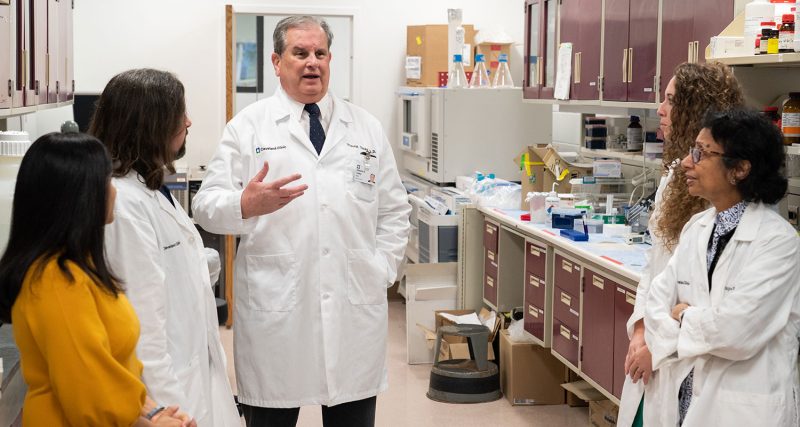Totalprestige spoke to Dr. Amit Kumar, President and CEO of Anixa Biosciences and Dr Vincent Tuohy of the Cleveland Clinic about their partnership in developing a breast cancer vaccine that could potentially eliminate breast cancer as a disease. That is a bold statement, but animal studies have demonstrated spectacular results and the United States government has agreed to fund the beginning of human studies. The technology was developed at the Cleveland Clinic by Dr. Tuohy and his research team, based on the discoveries they made regarding how breast cancer forms. Dr. Tuohy and the Cleveland Clinic have partnered with Dr. Amit Kumar and his Silicon Valley biotech company, Anixa Biosciences (NASDAQ:ANIX), to begin testing in humans and should the data mirror the data in animals, take the technology to commercialization.
Dr. Kumar, can you give us a little background about Anixa and how you came to the company? What excited you about Anixa?
Anixa is a relatively new biotechnology company. The predecessor company was a failed company in the electronics and IP licensing industry. When I got involved at the board level, the company had been delisted and was on the verge of going out of business. Over a period of time, we financed the company, and brought it back onto NASDAQ. In July 2017, I was Chairman of the Board, and at that time, I took on the additional roles of President and CEO, and we re-positioned the company as a biotech working on many exciting projects, of which the breast cancer vaccine is one. Our stock is traded on NASDAQ, the stock symbol is ANIX, and the website is www.anixa.com
Anixa is also very different from other biotech companies. We are executing a business model that has us working with the best cancer centers in the world to help develop and validate our products. This strategy enables us work to on multiple, diverse projects that each have potential multi-billion dollars of value as well as tremendous value for cancer patients. In that light, we are working on a liquid biopsy technology for early cancer detection, a therapy for ovarian cancer as well as the vaccine for breast cancer.
Your partnership with the Cleveland Clinic envisions a new approach to addressing breast cancer thanks to Dr Vince Tuohy’s research. Can you tell us how you and the Cleveland Clinic began working together?
I met Tony Giordano, who is a business development executive at the Cleveland Clinic, in early 2019. He introduced me to the breast cancer vaccine technology that Vince Tuohy had developed, and I was very intrigued. After meeting Vince as well as his R&D and clinical team at the Cleveland Clinic, and reviewing the animal data that they had completed, I was sold. I felt that Vince’s approach was a pathway to possibly eliminating some of the most aggressive forms of breast cancer and possibly all breast cancers. Vaccination against infectious diseases like smallpox, polio, and many others have had a profound effect on human health. In fact, vaccines have enabled mankind to completely eliminate some of these diseases. Before vaccines, some of these diseases were scourges on humanity. A few years ago, the first cancer vaccine was approved. This vaccine targets the cause of cervical cancer, as well as some other cancers. With this vaccine, we feel that within a generation, we can eliminate cervical cancer in the US, and if we can get this vaccine to the developing world, we can eliminate cervical cancer in the same way we have infectious diseases like small pox.
When I saw what Vince had done at the Cleveland Clinic, I realized his technology could potentially do the same with breast cancer. Breast cancer is the most common cancer in women, and a few men contract breast cancer as well. In the US alone, we spend close to $50 billion annually diagnosing, treating and performing research on breast cancer. If you count the supportive care, missed work, and other non-direct costs, the economic cost is exponentially higher. Worldwide, the number is even bigger. I am just talking about the economic value. We should not forget about the deaths, the debilitating surgeries, and the impact on the family enduring a battle with cancer. In addition, many women are getting prophylactic (preventative) mastectomies even though they are healthy, just because they do not want to get cancer. One high-profile case was that of movie star Angelina Jolie who had her breasts and ovaries removed so she would not contract cancer in those organs, because her heredity put her at high-risk.
Vince’s technology has the potential to eliminate breast cancer. Imagine if this works in humans as well as it works in the animal studies. In that case, women would simply get an injection and perhaps a booster shot, and may never have to worry about disfiguring and painful preventative surgery or contracting breast cancer at all. That would change the paradigm of cancer care and have an immeasurable impact on patients as well as our healthcare system.
Anixa Biosciences has been working on the fight against cancer for some time. The company’s partnership with the Cleveland Clinic is a logical step in building a better future that is able to combat cancers. The two groups will now lead the fight together and could be the ones to eliminate breast cancer completely.

Anixa Biosciences has been in a fight against cancer for some time now. How will partnering with the Cleveland Clinic improve your work at Anixa?
Our company partners with key scientists in academia to work on projects that we think will have great impact on cancer. We have two other programs in our portfolio. One project is a liquid biopsy to try to identify cancer at the earliest stages. We know that treating early stage cancers are much more successful than later stage cancers. A third project is a specialized technique to treat ovarian cancer, a cancer that has not had any real improved therapies for decades. But I feel the vaccine technology that we are developing with the Cleveland Clinic could have the greatest impact. Cleveland Clinic is regularly ranked as the best hospital in the US and the entire world. It is an honor for a young, small company like ours to be working with an institution of such high repute.
Obviously, it is too early to tell just what the partnership will be able to accomplish. That said, how do you see this working relationship changing medicine and the treatment of cancer?
The Cleveland Clinic team has been working on this vaccine for nearly a decade. So, there is a lot of research data. One of the most compelling pieces of data was the animal study testing the vaccination approach. Vince took a mouse that is genetically engineered to contract breast cancer. He immunized a group of these mice with his vaccine and had an equal number of the same type of mice injected with everything but the vaccine. Of the mice that got the vaccine, 100% of them did not get cancer. Of the control mice, 80% of them presented with breast cancer and died. It is rare to have such night and day experimental result. If this vaccine works in humans in the same way, we would expect all women who got vaccinated to never get breast cancer. Our plan is to work with Vince and the Cleveland Clinic to help take this vaccine into human testing. The animal data is very compelling, but we have to prove it works as well in humans and that requires human trials under the guidance of the US Food and Drug Administration. We hope to begin those trials in the coming year.
What can Anixa Biosciences offer Dr Tuohy in his work and development of the vaccine to fight breast cancer?
We will work with the team to begin and progress the clinical trial work. There are a number of steps, some of which are relatively quick and some of which will be long and expensive. We hope to work hand in hand with the Cleveland Clinic to progress the technology and to bring additional corporate partners to the table as well, when the trials get larger and once we near commercialization.
Over a quarter of a million women in the US will be diagnosed with invasive breast cancer in 2019. The number is staggering, but if the Breast Cancer Vaccine created by Anixa Biosciences and the Cleveland Clinic is successful, then that number could drop to an incredibly low figure. That figure could be zero.
In 2019, it was estimated over 268,000 women in the US would be diagnosed with invasive breast cancer. What will these numbers look like in the future if the revolutionary approach created by Dr Vince Tuohy is successful?
If in humans the performance is similar to what it was in animals, none of these 268,000 women will get breast cancer and no woman should die of breast cancer. Can you imagine a world where women don’t have to worry about the most common form of cancer in women? What an amazing world that would be.
If successful in treating breast cancer, is there a chance the vaccination created by Dr Tuohy can be used to treat other forms of cancer?
That is a very good question. The approach that Vince is using to develop the breast cancer vaccine, can be used for other cancer vaccines as well. In fact, Vince has also developed an approach to vaccinate against ovarian cancer, but that program is a year or two away from human testing. As we go forward, we hope to work with Vince on other cancer vaccines.
In 2018, it was claimed over 608,000 people in the US died of cancer. With new research being completed, do you see these numbers dropping in the next 10 years, staying the same, or increasing due to lifestyle choice?
I believe those numbers will get smaller. There are a number of factors that will drive those numbers lower. I am a member of the Board of Directors of the American Cancer Society, which is the larger cancer fighting charity in the world. We monitor carefully the cancer rates, mortality and other factors. Statistics show that one in two men will get cancer in their lifetime and one in three women will as well. We feel that the number of deaths will decline due to lifestyle changes (reduction in smoking, healthier lifestyles, etc.), early detection, and most importantly prevention. In addition, our understanding of how the immune system battles cancer is advancing quickly. Those scientific advancements will enable better ways to treat and prevent cancer, like Vince Tuohy’s vaccine technology.
We previously spoke in 2018 about Anixa Biosciences (formerly ITUS Corporation) and the early cancer detection technology it was working on. Can you tell us about any new developments Anixa Biosciences has made since then?
Yes, we will be launching later this year, our first product for detection of prostate cancer. We are rapidly completing the steps necessary to launch this test and we hope to have an impact on the way prostate cancer is diagnosed in this country.
You believe in being more proactive in the fight against cancer. How can modern medicine be more proactive in the search and treatment of cancer in patients?
If one studies the advances we have made in cancer care over the last century, there are some key points that emerged. The biggest impact on mortality has come from early detection and elimination of high-risk behavior like smoking. While we have made great advances in therapies, the impact there has been modest. That is why I am a firm believer in early detection and prevention. Prevention can be achieved in a number of ways, including lifestyle changes but also vaccination once proper vaccines can be developed.
Dr Tuohy’s and the Cleveland Clinic’s breakthrough vaccine has been years in the making. The group has been hard at work for nearly two decades from the initial plan to this stage. There has been a lot of work, funding, and trials that have gone into the vaccine. Now, he is ready to take it to the next level alongside Anixa Biosciences in hopes that someday soon women around the world will be given the vaccine to prevent breast cancer.

Dr. Tuohy, first off, can you tell us about the Breast Cancer Vaccine and how it targets cancer cells in women?
We modeled the breast cancer vaccine on the childhood vaccine program that protects against infectious diseases by providing pre-emptive immunity against attenuated pathogens before children engage the disease-causing variant. This prophylactic model is largely responsible for the dramatic increase in human life expectancy that occurred during the 20th century. Our challenge was to develop an adult vaccine program that would provide pre-emptive immunity against adult onset diseases like breast cancer. However, the immunity we needed to prevent breast cancer is very different from the more conventional antibody-mediated immunity that protects against infectious diseases. We had to create a cell-mediated immunity that recognizes the emerging breast tumors and prevents them from growing into mature destructive cancers. Also, we had to do this without inducing collateral damage against any normal tissues and without being able to target a pathogen because breast cancer and most other cancers are not associated with any definitive disease-causing pathogen. This was quite a challenge.
We identified a protein called α-lactalbumin that is produced exclusively in the normal breast tissues only during lactation and is not expressed at any other time in any other normal tissues. However, when breast cancer develops, this protein is once again produced. When we induced a powerful cell-mediated immunity to this protein in mice, it protected them from developing breast tumors and also inhibited the growth of established tumors and did so without inducing any detectable damage to any normal tissues. We subsequently found that α-lactalbumin is particularly expressed in triple negative breast cancers (TNBC), the most aggressive and lethal form of breast cancer and the most common form of this disease occurring in women at high genetic risk. Therefore, we believe the breast cancer immunity that we created can be effective as a treatment for established growing TNBC, but its greatest effectiveness occurs when it is used prophylactically to prevent tumors from growing in the first place.
How long has it taken from creating the vaccine to reach this point in your research?
Actually, I conceived this plan in 2002, and immediately started assembling the reagents and mice needed to test our “retired protein” hypothesis whereby normal self-proteins that are expressed in adult-onset cancers but are “retired” from expression in normal cells due to the natural aging process can serve as viable vaccine targets for inducing safe and effective cancer prophylaxis. This took several years to test and we published the results in Nature Medicine in 2010. It took a very long time to get the grant funding to move this discovery into clinical trials but we managed to do so in 2017 and are preparing to test our vaccine in phase I clinical trials very soon.
How significant is your partnership with Anixa Biosciences in the development of the Breast Cancer Vaccine?
I cannot say enough about the importance of our partnership with Anixa Biosciences. I have been spearheading the movement of our breast cancer vaccine from discovery and development, through the FDA regulatory process, and into clinical testing. This effort has been very difficult and often very frustrating. I am lucky to have a very talented and dedicated team at the Cleveland Clinic to facilitate this effort, but now I have a very supportive CEO in Dr. Amit Kumar who recognizes the feasibility of our vaccine in creating a paradigm change in controlling breast cancer and ovarian cancer. I think the support from Anixa and Dr Kumar guarantees the completion of our clinical trials and has already been productive with submission of a joint application for funding. I am delighted to continue working with Anixa and Dr. Kumar and look forward for some time to come to a successful and productive relationship.
Although things are moving forward quickly for the Breast Cancer Vaccine, Dr Tuohy stresses that things take time and it could be a while until the vaccine is made available to women. Due to the research, testing, trials, and reviews that go into the vaccine, commercialization may be years away.

When will the Breast Cancer Vaccine go into clinical trials with real patients?
We are currently assembling our application to the FDA and plan to submit our application by the end of 2019. We hope to have permission from the FDA to vaccinate human subjects soon thereafter. We anticipate starting our recruitment of test subjects for determining the safety and dosage of our vaccine in a phase I clinical trial by mid 2020.
If the vaccine is found to be effective in the fight against breast cancer, how long until it can go into production and be used in everyday medicine?
This question is always very difficult to answer because it requires substantial speculation on my part in anticipating whether the FDA will allow us to assess early efficacy of our vaccine using molecular indicators rather than waiting for complete overall survival data. The latter data could take ten years or more to collect and the FDA will rightfully be very cautious about safety before allowing our vaccine to have widespread use. In any event, no matter how long it may take, we must not hesitate to keep moving forward with our vision of a world without breast cancer.
Dr. Kumar has previously alluded to the Breast Cancer Vaccine being used in a similar way to children being vaccinated against smallpox and other preventable diseases. How significant would this medicine be to the world’s population?
We are always mindful of the fact that smallpox was once seen as an incurable disease that ravaged young people. However, the smallpox vaccine eradicated the disease. Now, it is hoped that the breast cancer vaccine will offer a pre-emptive strike against the most lethal form of breast cancer and prevent women from ever having to face it.
Current estimates indicate that by 2020, Medicare reimbursement costs for breast cancer will likely exceed $20bn annually. Considering that the median age of diagnosis of breast cancer is 62 years,these costs represent less than half of the total annual costs. Thus, in 2020 and every year thereafter, the costs to Americans for breast cancer will exceed $40bn annually. These built-in costs of breast cancer certainly dwarf whatever expenses may be needed to finance clinical trials for primary immunoprevention of this disease.
Successful induction of pre-emptive immunity against breast cancer would clearly have a dramatic impact on reducing the overall tumor burden in the USA and thereby reduce our annual healthcare costs. In the USA, there are over 268,000 new cases of breast cancer diagnosed each year, and worldwide there are close to 2 million new cases anticipated to be diagnosed yearly. I would think that the cost of screening, diagnosis, and treatment of breast cancer worldwide may conservatively cost at least $100bn a year. Thus, I think a preventive vaccine would have an enormous impact on global healthcare costs. I never really thought about the global impact of my work and am quite staggered by this potential. I cannot think of anything more impactful that I could do other than creating and testing vaccines to prevent adult-onset cancers and finally addressing these great unmet needs in our healthcare. I couldn’t be more excited about the possibilities of such a paradigm-changing strategy for controlling so many lethal diseases that impact so many lives worldwide.

The Breast Cancer Vaccine would be used to vaccinate women over 40-years old at risk of cancer. Is there a chance it could be used on younger women as a preventative measure?
We have certainly made arguments in the past about how our vaccine that targets a lactation protein can be administered to women over 40 years of age because 95% of all breast cancers occur in women over 40 and only 3% of children are born to women over 40. It seemed to us in the beginning that most 40-year-old women have ended their childbearing years and have entered their breast cancer susceptibility years and could get vaccinated against α-lactalbumin without adversely affecting lactation.
However, we now realize that women with the greatest need for a preventive vaccine are those at high-risk due to carrying mutations in their BRCA1 or BRCA2 genes. About 70% of women with these mutations develop breast cancer in their lifetime, and the most common form of breast cancer that they get is TNBC. Thus, ultimately, we would like to make our vaccine available to women that have completed their childbearing years. However, for our initial clinical trials, we will focus on women at high genetic risk who have the greatest need for a preventive vaccine since their only alternative to lower their breast cancer risk is bilateral mastectomy and subsequent reconstructive plastic surgery. Personally, I think a preventive vaccine is a much less traumatic and a much more civilized alternative to such traumatic surgical intervention.
If successful in the next stage of trials, would you move onto developing a vaccine for other types of cancers such as testicular or ovarian cancer?
We did develop a vaccine for testicular stromal cell cancer a few years ago. It was very effective in our preclinical studies in mice. However, the incidence of this disease in humans is very low making it extremely difficult to recruit sufficient patients for clinical testing and extremely difficult to secure the funding for such a rare though very lethal form of testicular cancer. We are much more focused now on our ovarian cancer vaccine which is designed to prevent ovarian cancer, the most lethal of all female-specific cancers. To me, ovarian cancer is a disease that screams “PREVENT ME!!” because it is typically diagnosed late at advanced stages, resistance to treatment is common, and 52% of all women die from this disease within five years of their diagnosis. We have already applied for funding to complete the preclinical studies for our ovarian cancer vaccine and hope to start clinical trials within the next year or two. What strikes me today is that we have no adult vaccination program to prevent the cancers we confront with age. Such a program is long overdue because it is simply unacceptable that in the United States, one in eight women will develop breast cancer, one in six men will develop prostate cancer, and ovarian cancer kills most of the women soon after their diagnosis. The 21st century must bring us safe and effective pre-emptive immunity against these common and lethal adult onset cancers and extend human life expectancy in the same way that childhood vaccinations did in the 20th century. This to me is the real “moonshot” program. It is my dream that when when my grandchildren reach middle age, they get their breast, ovarian, and prostate cancer vaccines and are thereby protected from these diseases in the same way they were protected from so many infectious diseases by the childhood vaccination program. Indeed, the job of our immune system is to keep us healthy, but to do this, it needs instructions, and vaccines are simply instructions for our immune system, so it knows exactly what to do to protect us from disease. I think we have only just begun to realize how much disease protection our immune system can provide. It is an exciting time for testing the limits of what our immune system can do to control so many cancers.
Dr. Tuohy, the Cleveland clinic previously received $6.2 million in grant money from the US Department of Defense. What was the DoD’s role in the development of the vaccine and motivation behind granting the funds?
At first, it may seem surprising that the Department of Defense would be interested in supporting efforts to prevent breast cancer. However, it is a little-known fact that military families have a higher incidence of breast cancer than the rest of the American population. We don’t know why this is the case, but it is nevertheless a good reason for the DoD to finance our proposal and provide the funding needed to test our breast cancer vaccine in clinical trials.
How will treating patients before they develop breast cancer rather than after they develop it change medicine?
I think it is important to change the language here. We are not treating patients before they develop disease because treatment implies that there is a disease in place to begin with. Administration of a preventive vaccine for breast cancer is the opposite of a treatment because prevention implies that the disease never occurs and precludes any need for treatment.
Our breast cancer vaccine is designed to prevent the need for treatment. Our approach represents a paradigm change in the way to control breast cancer, ovarian cancer, and hopefully other adult-onset cancers. Instead of waiting for these cancers to occur and going on offense to beat the daylights out of the cancer (and the patient) with surgery, chemotherapy, radiation therapy, hormone therapy, and immunotherapy, we are going on defense before the cancer appears so we can reduce the overall tumor burden and the need for treatment.
Such a paradigm change brings with it a wonderful opportunity to dramatically alter the natural history of these adult onset cancers. I am delighted to have this opportunity and eagerly look forward to determine whether we can eliminate several adult-onset cancers in our lifetimes. I cannot begin to tell you how excited I am about this opportunity and how excited our entire team is in being involved in this magnificent journey with Dr. Kumar and Anixa Biosciences.
So, what would the world be like without breast cancer? It is a world that many believed would never occur. However, with Anixa Biosciences and the Cleveland Clinic working together, they are attempting to eliminate one of the worst diseases in the world today. Vaccines to eliminate childhood diseases changed the world in the 20th century. Now, vaccines to prevent cancer in adults could be the major medical breakthrough of the 21st century.
For more information, please visit https://my.clevelandclinic.org/ and https://www.anixa.com/
Images credit: Larry Spencer and Brian Byllesby

Journalist and author. Contributor











